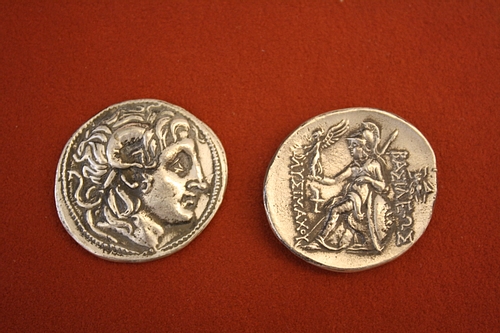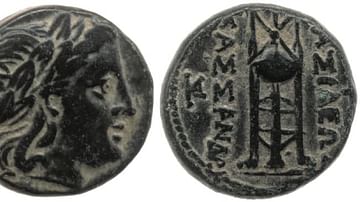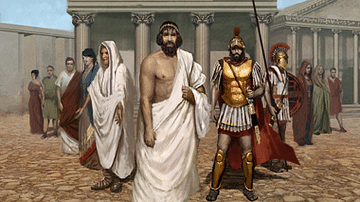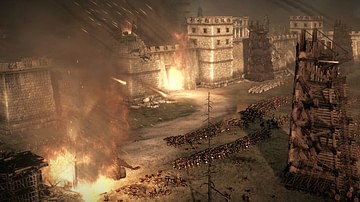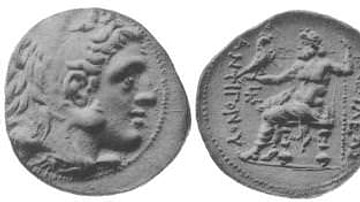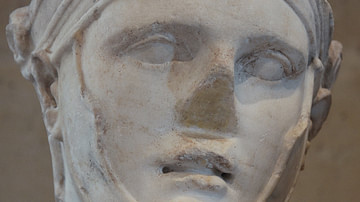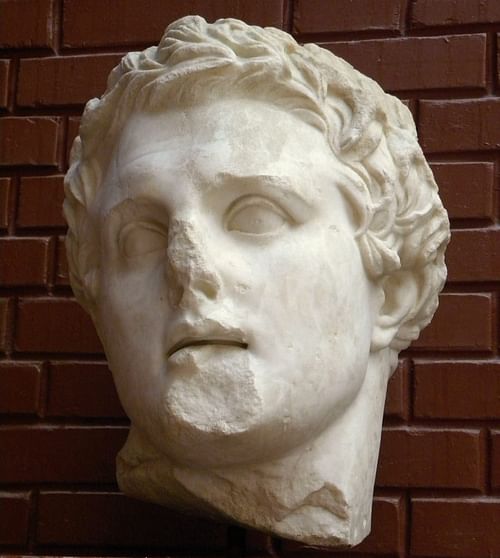
Lysimachus (c. 361-281 BCE) was one of Alexander the Great's trusted bodyguards and a member of his Companion Cavalry. Although he obtained Macedonian citizenship, his father was a Thessalian named Agathocles. After Alexander's death in 323 BCE, Lysimachus benefitted from his loyalty to the king by being rewarded with the strategically important province of Thrace, an area northeast of Macedon along the Black Sea coast. While he initially remained relatively uninvolved in the series of wars that immediately followed Alexander's death, he eventually sought to expand his land holdings and ultimately joined his fellow commanders in a war against Antigonus Monophthalmus (the One-Eyed) and his son Demetrius I of Macedon. Success would follow but at a hefty price.
ALEXANder's Bodyguard
Educated at the royal court in Pella, Lysimachus rose to become a prominent member of the king's entourage, one of his bodyguards or somatophylax by 328 BCE. Oddly enough, there was another Lysimachus in the entourage of Alexander. This second Lysimachus was one of the king's former tutors, better known, as one historian stated, for his sense of humor rather than hygiene. He called the young Alexander Achilles while he referred to himself as Phoenix, Achilles' tutor. Although historians record that he accompanied the king on the invasion of Persia, his only appearance of note was at the siege of Tyre.
There is some disagreement over the exact year of Lysimachus's birth. Some historians give the year as 361 BCE while others say he was born around 355 or 351 BCE in Pella, the capital of Macedon. The earlier date is more plausible. If he had been born in 355 BCE or later, he would have been too young to have accompanied the king to Persia as a bodyguard. Although early histories state that he accompanied the king in his war against the Persians and King Darius, little is known about Lysimachus participation before Hydaspes. Historians write of his involvement in Alexander's battle of the Hydaspes against King Porus - it was recorded that he crossed the river with the king - and the siege of the Indian city of Sangala. Apparently, he was wounded at this siege. The historian Arrian, in his The Campaigns of Alexander, wrote,
Throughout the siege Alexander lost a little under 100 men; the number of wounded, however, was disproportionately large – over 1,000, among them being Lysimachus, of Alexander's personal guard, and other officers. (290)
For this bravery and loyalty to the king, he was rewarded with Thrace whose importance lay in its location adjacent to the Hellespont, the bridge between Asia and Europe.
Governor of Thrace
On June 10, 323 BCE, Alexander the Great died in Babylon. Historians, both past and present, argue over the exact cause, nevertheless, he died without naming a successor or heir, causing his empire to descend into chaos. Although the commander Perdiccas possessed the king's signet ring, arguments persisted and no consensus could be reached. While waiting for Alexander's son, the future Alexander IV, to come of age, the commanders divided the empire among themselves - Ptolemy I took Egypt, the elderly Antigonus obtained parts of Asia Minor, the regent Antipater I retained Macedon and Greece, and lastly, Lysimachus received Thrace. His fellow bodyguard Lennonatas accepted the province of Phrygia, located across on the Asian side of the Hellespont - an arrangement that caused constant friction between the two.
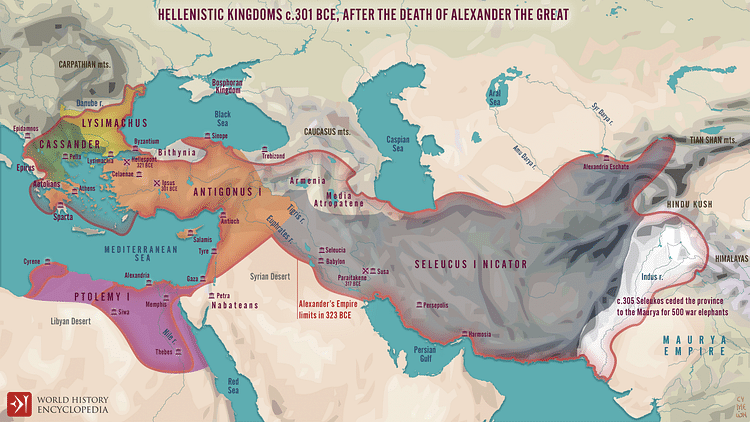
For the next three decades, alliances would be made and broken. Enemies became friends, and friends became enemies. The empire that Alexander had built would never be reunited. His mother, wife, and only son and heir would die on the orders of Cassander, Antipater's son, never having sat on the throne.
Lysimachus' first duty upon his arrival in Thrace was to pacify the diverse Thracian tribes. Although the Thracians joined in the fight against Darius, they had always been a people antagonistic to both Philip II and Alexander. The young ruler immediately established himself against the leader of a key Thracian dynasty, the Seuthes. Since the majority of Alexander's empire had been divided among his more prominent commanders, they busied themselves in what became known as the Wars of Succession or Wars of Diadochi. Since they fought among themselves with little interest in either Thrace or Phrygia, Lysimachus realized his good fortune and avoided getting involved. In Thrace he was fairly safe from the intrigues and scheming of his fellow commanders - no one outside the province challenged him - at least for a while. He concentrated his efforts on establishing a strong power base, but at one point, in 315 BCE he was forced to suppress a revolt staged by one of the cities along the Black Sea coast.
Eyeing the strategically important province for himself, the commander Antigonus who reigned over much of Asia Minor sent a small contingency to aid the city and provoke the local tribes. Finally, in 311 BCE, peace was achieved with Lysimachus remaining in control of the hostile city. This revolt would finally draw him into the conflict that he had so long sought to avoid. He formed an alliance with Cassander of Macedon, Ptolemy, and Seleucus I. To safeguard the area and secure the Dardanelles, he promptly built a new city in 309 BCE, Lysimachia, on the Gallipoli peninsula.
Family affairs
From the time he was named ruler until his death in 281 BCE, Lysimachus used marriage to secure his position in Thrace and establish necessary beneficial alliances. After the commander Perdiccas, who would soon die at the hands of his own men, refused to marry Antipater's daughter Nicaea, the wise Thracian ruler married her in 321 BCE, securing an alliance with both Antipater and his son Cassander. They would have three children: one son, Agathocles, and two daughters. Lysimachus would later support his brother-in-law against Polyperchon for the regency of Macedon and Greece. After the death of Nicaea, he chose to marry the daughter of Ptolemy I and his mistress Bernice, Arsinoe II, around 300 BCE. It was a marriage he would regret. For reasons unknown (probably to secure the throne of Thrace for her own son), Arsinoe convinced her husband to kill his oldest son and heir Agathokles on the trumped-up charges of treason. The murder of the popular young commander caused an uproar among many of his fellow officers who chose to desert to the army of Seleucus, now the adversary of Ptolemy. After Lysimachus' death, she would marry her half-brother Ptolemy II, establishing the precedent of brother-sister marriages in Egypt.
Wars of the Diadochi
Like many other commanders, Lysimachus assumed the title of king in 305 BCE. With the memory of Antigonus' recent attack fresh in his memory, the king set his expansion sights on Asia Minor. He allied with Seleucus and Cassander against the elderly Antigonus and his son Demetrius at the Battle of Ipsus in 301 BCE; a battle that would bring about both the defeat and death of Antigonus. According to the terms of peace, Lysimachus was rewarded with additional lands in Asia Minor to the south of the Taurus Mountains, Seleucus received Syria, and Cassander's position was established securely in Macedon and Greece. According to many historians, the battle put an end to any hope of re-establishing Alexander's empire.
The riches of the area around Pergamon along the Mediterranean coast of Asia Minor helped Lysimachus to expand his territory further. After the death of Cassander in 297 BCE, he set his sights on Macedon. With the assistance of King Pyrrhus of Epirus, he moved across the border and forced Demetrius out. Demetrius and his army moved across the Hellespont and into Asia Minor, confronting the forces Seleucus. Unfortunately for the one-time ruler of Macedon, he was immediately captured only to die in captivity in 283 BCE. Lysimachus' hopes for expansion were temporarily halted when he was captured in 292 BCE by Dromichaites, the king of Getae. He was forced to not only buy his freedom but also surrender a portion of his Trans-Danubian territory. In 282 BCE his one-time ally Seleucus set his sights on Lysimachus's territory in Asia Minor. In 281 BCE the two armies met at Corupedium where the king of Thrace met his death. With no heir, his small piece of the empire would fall into disarray.
